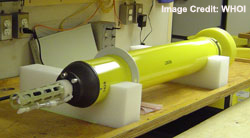Argo Profiling Floats Overview
Overview | Results
 The profiling temperature/salinity (Argo-type) floats were deployed to quantify the temporal evolution of the upper ocean temperature and salinity fields in the recirculation gyres and adjacent waters both north and south of the Kuroshio Extension. The floats provide information on near-surface temperature and salinity, the seasonally evolving mixed layer and pycnocline, and the deeper subtropical mode water and intermediate waters, as well as for the calculation of drift velocities at the ocean surface and at the parking depth. The University of Hawaii component of KESS is responsible for this element of the overall KESS observation program. During the first two cruises in 2004, 20 profiling floats were deployed within the recirculation gyre region to the south of the Kuroshio Extension. During the 2005 cruises, an additional 28 profiling floats were deployed both north and south of the Kuroshio Extension. No additional deployments are planned.
The profiling temperature/salinity (Argo-type) floats were deployed to quantify the temporal evolution of the upper ocean temperature and salinity fields in the recirculation gyres and adjacent waters both north and south of the Kuroshio Extension. The floats provide information on near-surface temperature and salinity, the seasonally evolving mixed layer and pycnocline, and the deeper subtropical mode water and intermediate waters, as well as for the calculation of drift velocities at the ocean surface and at the parking depth. The University of Hawaii component of KESS is responsible for this element of the overall KESS observation program. During the first two cruises in 2004, 20 profiling floats were deployed within the recirculation gyre region to the south of the Kuroshio Extension. During the 2005 cruises, an additional 28 profiling floats were deployed both north and south of the Kuroshio Extension. No additional deployments are planned.
All 48 floats were APEX floats manufactured by Webb Research Corporation. Each of the profiling floats measures temperature and salinity at the parking depth (about 1500 db), and at 72 specified pressures beginning at 1400 db as it ascends. The sampling intervals are 100 db below 1,000 db, 30 db between 400-1,000 db, 10 db between 100-400 db, and 5 db between 5-100 db. Each float provides a temperature and salinity profile as well as position information every 5 days. The data are available in real-time via the GTS, and via the normal Argo-float data-management procedures. Some of the KESS profiling floats should continue to report data until sometime in 2008. Over the total deployment time period, the floats will have measured the temperature and salinity fields over a range of spatial scales: at higher-resolution scales (100-200 km) near deployment and, as the floats disperse, on an Argo-like and regional-array spatial scale (3 degrees) for up to a total of four annual cycles.